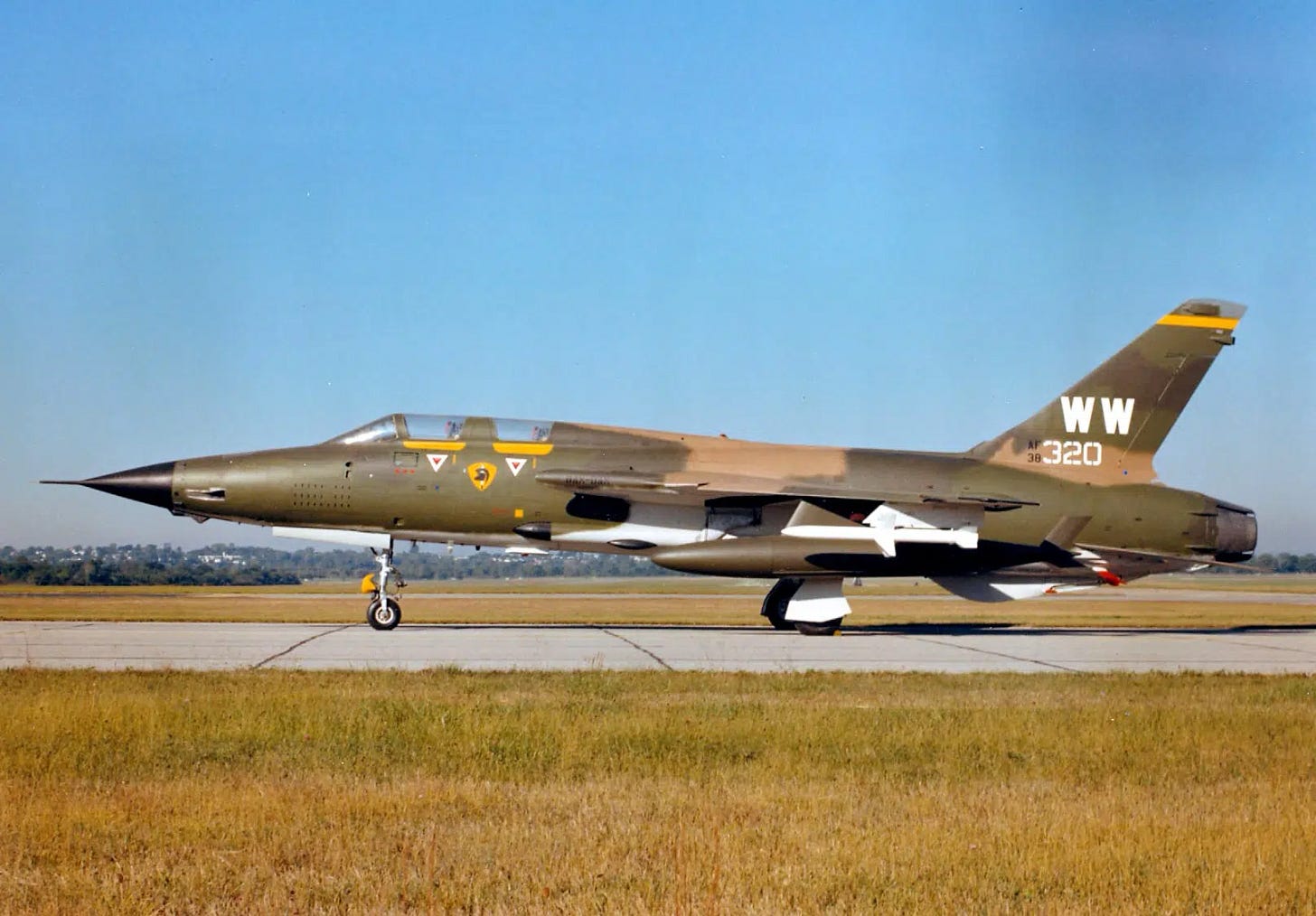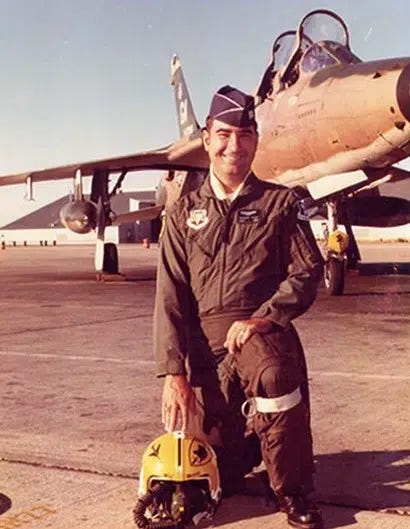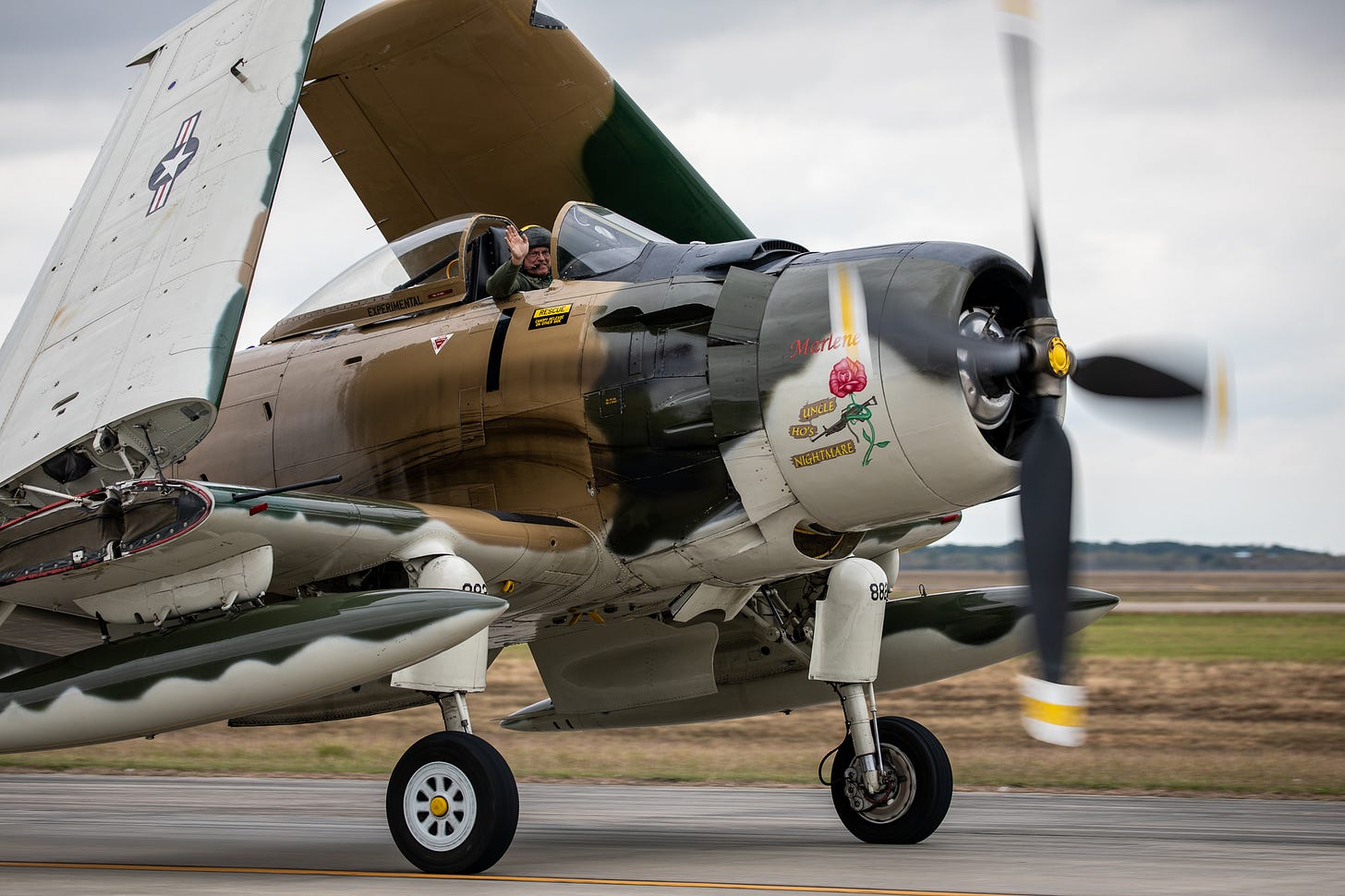Chrome Lightnings and looking back on a heroic Thud pilot
F-35Cs with chrome finishes spotted and remembering the sacrifice of an F-105 pilot
“Children often ask me, they say, 'Well, how do you become a fighter pilot, or how do you become an astronaut, or...?' And I say, 'Love what you're doing and do it very well.”
-Gregory H. Johnson
Mission Briefing: The Mysterious Chrome F-35C and Its Vanishing Coating
Recently surfaced photos have shed new light on the U.S. Navy’s experimental "chrome" F-35C, revealing how its unique mirror-like coating degraded over time before the aircraft returned to its standard livery.
Captured at Midland Airport, Texas, in November 2022, the images—shared by aviation photographer @TimHPatriot—show the F-35C BuNo 168842 parked on the ramp, its once-pristine reflective coating showing significant signs of wear.
A Closer Look at the Coating’s Purpose and Challenges
The mirror-like tiles, initially speculated to be an infrared (IR) signature-reduction measure, were reportedly intended to combat the effects of salty air on the aircraft’s skin. However, according to the pilot, the tiles had a major drawback—they frequently peeled off in flight. This issue suggests that the coating may have been applied using an adhesive, similar to temporary vinyl wraps used for special liveries.
This was not the only F-35C to receive the experimental treatment. A separate aircraft with a similar coating was tested aboard the USS Abraham Lincoln (CVN 72), while others were frequently spotted at Edwards AFB and Nellis AFB—environments known for extreme conditions that put aircraft materials to the test.
Parallels with the Chrome Raptors
The F-22 Raptor was the first aircraft to be spotted with this experimental coating. The Raptor’s radar-absorbent material (RAM) is notoriously difficult to maintain, often showing heavy deterioration, especially on non-combat coded aircraft used in training. A U.S. Air Force test pilot from the 422nd Test and Evaluation Squadron (TES) once stated that these coatings were experimental solutions aimed at improving maintenance and aircraft sustainability.
If this same logic applied to the F-35C, it would align with reports that the aircraft’s RAM deteriorated rapidly in harsh maritime environments. During early deployments, corrosion and wear were observed on the stealth coatings of carrier-based F-35Cs, with rusty-looking deposits forming on the fuselage.
The Fate of the Chrome F-35C
By mid-2024, BuNo 168842 was spotted at Edwards AFB, with later photos showing it arriving at Naval Base Ventura County (NBVC) Point Mugu. The aircraft, assigned to Air Test and Evaluation Squadron Nine (VX-9) at China Lake, was ultimately seen in early 2023 without its mirror-like tiles, restored to its standard grey livery. It also underwent a designation change, shifting from XE-105 to XE-101 while remaining part of VX-9.
While the exact purpose and effectiveness of the chrome coating remain classified, speculation persists. Theories range from IR signature reduction and radar-absorbent material replacement to potential passive laser defense applications. Without official confirmation, its true purpose remains an intriguing mystery.
Testing the Coating at Sea
Another F-35C featuring a partial mirror-like finish was spotted aboard USS Abraham Lincoln on November 30, 2023, during touch-and-go operations. This time, the coating was less extensive, appearing only on the vertical tails and wings rather than across the entire aircraft. The chrome pattern alternated between dark and reflective sections, forming three distinct color bands.
This marked the first known instance of an F-35C with this coating operating in a carrier environment. Whether this test was focused on evaluating the coating’s resilience in high-tempo maritime operations remains unknown.
Final Thoughts
The "chrome" F-35C remains one of the more intriguing experimental aircraft developments in recent years. As more images and reports emerge, the story of this reflective fighter jet may finally come into focus. Check down below for a video all about the Chrome F-35C Lightning
This Week in Aviation History
The Final Flight of Thud 71
On March 2, 1978, Major Charles Thomas Fulop and First Lieutenant William A. Stone took off from George Air Force Base, California, in their Republic F-105G Thunderchief (serial number 63-8321), call sign "Thud 71." Their mission: a routine instrument training flight, conducting approaches and departures at NAS Point Mugu before returning to base.
However, weather conditions over Point Mugu were poor, with heavy clouds, rain, and fog. After executing a missed approach, Major Fulop requested an immediate return to George AFB due to an unspecified issue. Moments later, he declared an emergency, reporting a failed altimeter and his attempt to climb above the cloud cover.
Tragically, Thud 71 never made it back. Witnesses in Thousand Oaks and Newbury Park saw the aircraft emerge from the overcast in a steep dive. Major Fulop initiated ejection for his Electronic Warfare Officer, Lieutenant Stone, who survived with a broken arm.
Instead of abandoning the aircraft, Major Fulop stayed in the cockpit, steering away from populated areas. Thud 71 crashed into Hill Canyon, exploding on impact. Major Fulop was killed, but his actions likely saved lives on the ground.
Remembering Major Charles T. Fulop
Born on October 6, 1946, in Barberton, Ohio, Charles Fulop graduated from Miami University in 1968. He joined the U.S. Air Force in 1969, initially serving as a B-52 navigator before earning his pilot’s wings in 1973. He later flew the F-4 Phantom II at Homestead AFB before transitioning to the F-105G Wild Weasel III with the 561st Tactical Fighter Squadron, 35th Tactical Fighter Wing.
He is buried at Saint Mary’s Catholic Cemetery in Sacramento, California, leaving behind his wife, Cheryl, and two daughters, Michelle and Kelley.
The F-105G Wild Weasel: A Warrior’s Aircraft
The Republic F-105G Thunderchief was a powerful and complex aircraft designed for the "Wild Weasel" mission—hunting and destroying enemy radar-guided surface-to-air missiles (SAMs). The F-105 was the largest single-seat, single-engine combat aircraft ever built, capable of speeds exceeding Mach 2. Its Pratt & Whitney J75-P-19W turbojet engine could produce up to 26,500 pounds of thrust with water injection.
Equipped with AGM-45 Shrike and AGM-78 Standard HARM missiles, the F-105G played a crucial role in Vietnam, suppressing enemy air defenses. A total of 65 F-105Fs were converted into F-105G Wild Weasel III variants.
One of Thud 71’s sister aircraft, F-105G 63-8320, achieved three air-to-air victories against enemy MiGs. Today, it is preserved at the National Museum of the United States Air Force at Wright-Patterson AFB.
Major Charles T. Fulop made the ultimate sacrifice in the cockpit of Thud 71—a final act of heroism that deserves to be remembered.
In Case You Missed It
More about the chrome coated lightnings:
Photo Outlet
Every issue of Hangar Flying with Tog gets you a free image that I’ve taken at airshows:
Feel free to use these photos however you like, if you choose to tag me, I am @pilotphotog on all social platforms. Thanks!
Post Flight Debrief
Want to keep getting this newsletter straight to your inbox? Just sign up using the form below—it's that easy! This newsletter will always be free for everyone, but if you’d like to support the mission and unlock even more, consider becoming a paid subscriber. Either way, I’m grateful for your support. Sign up now and stay in the loop!
-Tog







